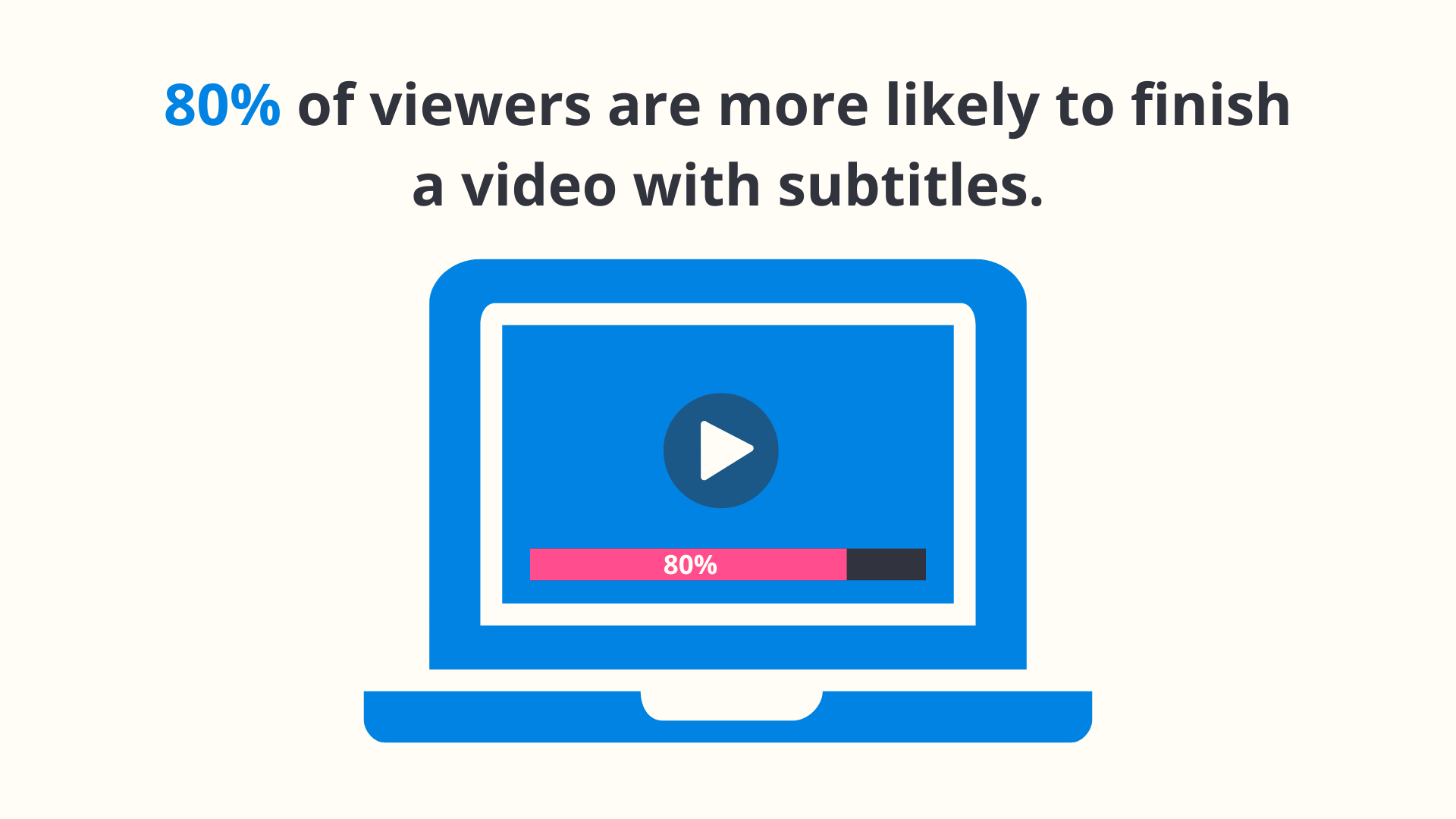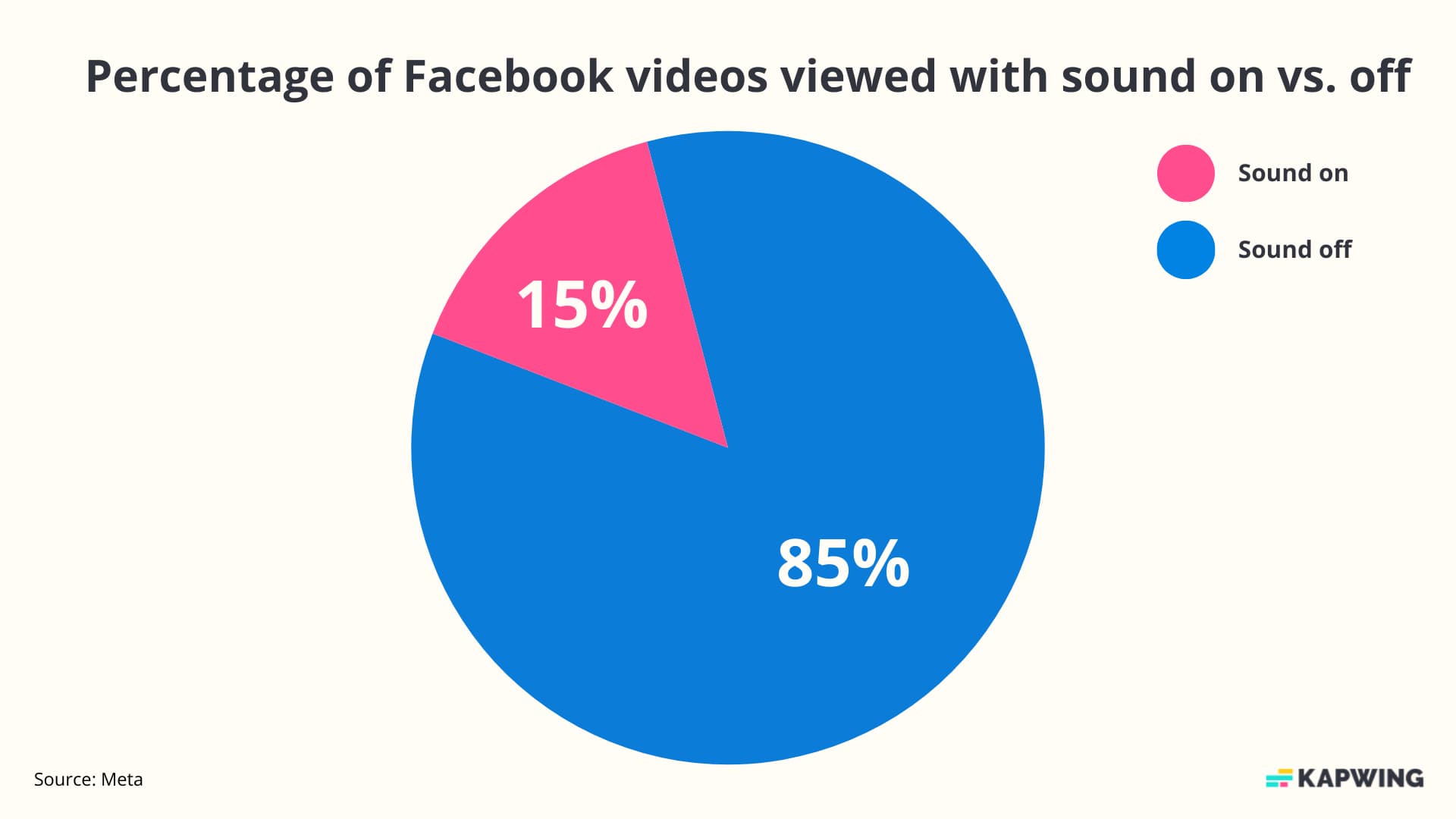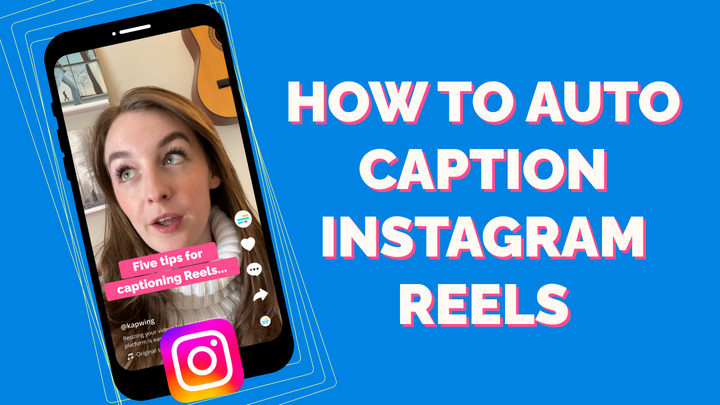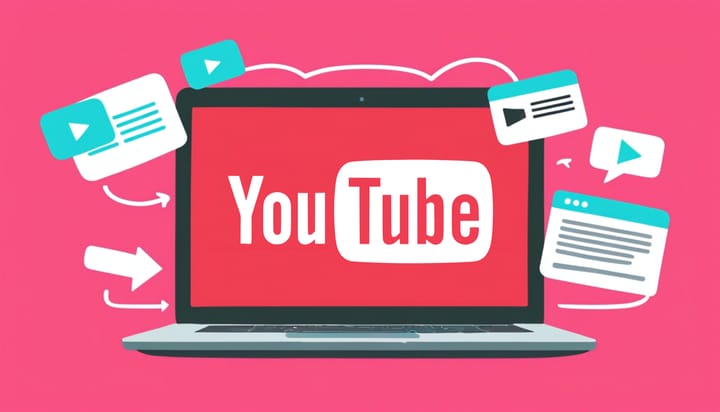80% of People Prefer Video Subtitles. Here's How they Affect Engagement.
Subtitles are greatly preferred by video viewers across all platforms, especially on mobile. Here's how subtitles affect engagement of your videos.

Most people use video subtitles and captions at least some of the time when watching content. 50% of Americans turn on subtitles “most of the time.” That number jumps all the way up to 80% for Gen Z.
And it’s not just personal preference. Data shows that subtitles and captions matter for viewer retention and engagement, too (aka what really matters to brands and creators).
If you’ve ever wondered if adding subtitles to your videos is worth the effort, then keep reading—we're covering all of the most interesting data about subtitles, who uses them, and how they affect viewer behavior and engagement. (Note: Kapwing's Subtitle Generator makes creating subtitles fast and easy.)
Let's get into the data.
📊 Fast facts about video subtitles:
- 80% of viewers are more likely to finish a video with subtitles
- 85% of all videos on Facebook are watched with the sound off
- 80% of viewers respond negatively to video ads that auto-play sound
- 37% of viewers said video subtitles encourage them to turn the sound on
- One company saw an 7.32% total increase in YouTube views after adding subtitles
- 61% of people who localize their video content translate their subtitles
How many people use video subtitles?
A joint study from Verizon and Publicis Media found up to 80% of viewers are more likely to finish a video with subtitles. Half of those viewers preferred captions because they like watching videos with sound off.
Where and when a person is watching the video matters, too. 69% of viewers watch video with the sound off when they're in public places, while only 25% turn the sound off when they're in a private place or alone. 92% of viewers watch videos with the sound off on mobile devices; across all devices, this number drops to around 83% of viewers.
There seems to be a generational divide at play. Gen Z is much more comfortable watching content in public: one study shared that 74% of Gen Z watch videos in public on their smartphones, compared to 57% of the total US population.
Platforms affect a viewer's preferences as well: Meta famously reported that 85% of all Facebook videos were being watched with the sound off. Preference for subtitles is still strong for longer-form videos as we'll cover below, but this is a good signal that captions go from nice-to-have to must-have for short-form video on social media.

In the original study published by Meta, there was even more data that caught our eye. Although the research focused primarily on video ads, many of these finding apply to organic social as well:
- 80% of viewers responded negatively to video ads with auto-playing sound
- Subtitles increased view time on video ads by an average of 12%
- Viewers found 41% of videos "meaningless" (hard to understand) without sound; Facebook recommends subtitles as a way to fix this problem
Many companies have since run their own small experiments with subtitles, even across other platforms. For example, Discovery Digital Network, a YouTube channel with around 100 million videos ran a test with their own content to see how subtitles affected video views. They found that adding subtitles to YouTube videos resulted in a 7.32% total increase in views.
One of the most common reasons cited for turning on subtitles is that they make it easier to focus on the video’s content. According to data from Stagetext, 42% of people say that they use subtitles or captions to help with concentration, which allows them to watch longer.
So, we have strong evidence that viewers greatly prefer videos with subtitles. But does that mean viewers are really engaging with these videos, rather than just passively watching?
Do video subtitles increase engagement?
At least for video ads, the answer appears to be "Yes." The Verizon and Publicis Media study found subtitles helped contribute to:
- an 8% lift in ad recall
- a 10% lift in "ad memory quality"
- a 13% lift in brand linkage, or tying the ad to the brand it was from
What's more, subtitles can encourage viewers to listen to videos: 37% of viewers said subtitles encourage them to turn the sound on since the captions make the video seem more interesting; 29% said they understand videos better with subtitles, even when the sound is on.
There seems to be a lone exception, at least according to this study: when both subtitles and the brand's logo were prominently featured in the video, viewers experienced a "12% decrease in ad memory," or their ability to recall the video ad at a later time. Maybe it's sensory overload. In either case, it prompts brands to consider focusing on catching and keeping viewers through video subtitles.
And as we've covered before, the fonts used for your subtitles can have a dramatic impact on whether they're legible and easy to remember for the viewer, or confusing and frustrating.
Do subtitles increase your content’s reach?
They can, in more ways than one.
Social media channels and video platforms like YouTube reward captioned content with greater visibility. There are a couple of reasons for this.
First, platforms tend to surface content that aligns with user behaviors and preferences. People prefer videos with subtitles, so the platforms want to give them that. And secondly, adding auto-generated captions gives the algorithm more video information to index.
This is true for traditional SEO as well.
According to 3Play Media’s 2023 State of Captioning report, less than 5% of people cite SEO benefits as a reason to add captions to their videos. But adding subtitles can definitely boost your videos in the SERP. Captions increase views and watch time, which are factors both YouTube and Google use when determining which videos to recommend in search results.
And, just like on social media channels, subtitles provide crawlable metadata that search engines can index and analyze to match your content to search queries.
Another way subtitles can help expand your reach is through video localization.
In that same State of Captioning report, 3Play found that only 43% of people are translating their video content. The main reason cited was a lack of resources–both budget and time.
Adding translated subtitles is one of the most accessible ways to localize your content. In fact, 61% of people who do localize their content use translated subtitles to do so, compared to just 12% who use dubbing.
Which generations use subtitles the most?
Subtitles are popular with non-hearing impaired users, too, especially in younger generations. One study found that 80% of respondents in the 18-25 age group say they watch TV (on any device) with subtitles on "some or most of the time," the most of any age group.
That's despite the fact that this age range had the fewest number of viewers with hearing problems.
Subtitles and captions are obviously very important features for hearing impaired viewers—one reason we believe every video should try to include subtitles is for accessibility.
It's interesting to consider whether short-form videos on social media and their near-universal use of subtitles are driving this trend in younger audiences. Younger viewers may simply be more familiar with watching videos with subtitles and can follow along even with the text on screen.
Why do people use video subtitles?
What are the most common reasons why people use subtitles with videos? Survey data from Preply suggests that viewers preference for subtitles can run the gamut:
- 75% of viewers said they use subtitles due to the poor audio quality of videos
- 29% of viewers use subtitles to not disturb the people around them
- 27% of viewers said subtitles help keep them focused on what they're watching
Accessibility is another major concern. According to the report from 3Play, captions or SDH subtitles are the most commonly used accessibility feature when viewing online content with 87.6% of users turning them on.
And while accessibility is reason enough to add subtitles to your videos, it also appears that subtitles have outgrown their original purpose and are now greatly preferred by viewers without hearing issues for a wide range of reasons.
How do people add subtitles?
Did generating subtitles become more accessible because users prefer subtitles? Or did user preferences shift as subtitling videos became easier and therefore more commonplace?
Probably a little bit of Column A, a little bit of Column B.
One of the things that’s been leveling the playing field is how much better auto-subtitling software has gotten. Just four years ago, automated captions were averaging 60-80% accuracy ratings and weren’t recommended for accessibility purposes.
Now, though, the industry average for AI-generated transcription and subtitling is a 10-15% Word Error Rate (WER). Which is why most people use auto-subtitles to caption their videos.
According to the 3Play Media 2023 State of Captioning report, more than 70% of surveyed respondents use auto captions, with or without some level of manual editing.
Subtitles are part of modern video production
The most opinionated conclusion we can make about this data is that subtitles are now part of the modern video. Your video isn't done until the subtitles are added.
Viewers with hearing issues will thank you for being considerate and making accessible content. And viewers who simply prefer subtitles will engage with your videos in more locations and contexts—and watch for a longer time—than if your video didn't include subtitles at all.
And with tools like Kapwing, which adds word-by-word captions that you can edit in a single click, there's no reason not to add subtitles to your videos.
Read these next:
- How to Use the Classic Yellow Subtitle Font in Your Videos
- How to Add Custom Color Captions to Any Video
- How to Add Captions to Your TikTok Videos
- How to Add Caption to Twitter Videos
- How to Make an SRT File for Social Media Videos









